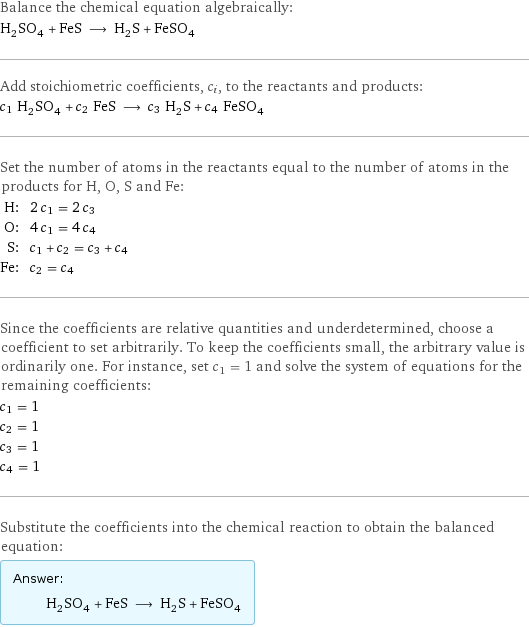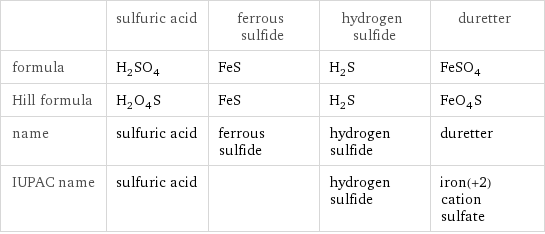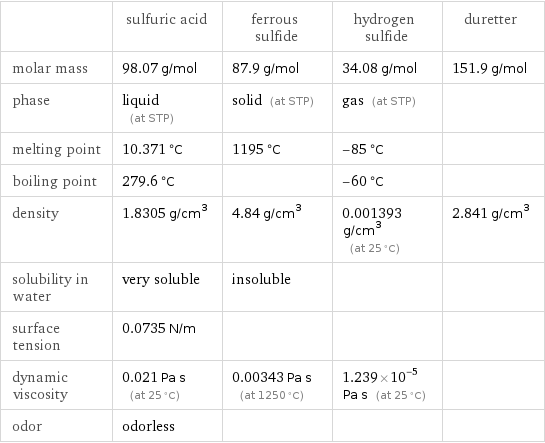Input interpretation

H_2SO_4 sulfuric acid + FeS ferrous sulfide ⟶ H_2S hydrogen sulfide + FeSO_4 duretter
Balanced equation

Balance the chemical equation algebraically: H_2SO_4 + FeS ⟶ H_2S + FeSO_4 Add stoichiometric coefficients, c_i, to the reactants and products: c_1 H_2SO_4 + c_2 FeS ⟶ c_3 H_2S + c_4 FeSO_4 Set the number of atoms in the reactants equal to the number of atoms in the products for H, O, S and Fe: H: | 2 c_1 = 2 c_3 O: | 4 c_1 = 4 c_4 S: | c_1 + c_2 = c_3 + c_4 Fe: | c_2 = c_4 Since the coefficients are relative quantities and underdetermined, choose a coefficient to set arbitrarily. To keep the coefficients small, the arbitrary value is ordinarily one. For instance, set c_1 = 1 and solve the system of equations for the remaining coefficients: c_1 = 1 c_2 = 1 c_3 = 1 c_4 = 1 Substitute the coefficients into the chemical reaction to obtain the balanced equation: Answer: | | H_2SO_4 + FeS ⟶ H_2S + FeSO_4
Structures

+ ⟶ +
Names

sulfuric acid + ferrous sulfide ⟶ hydrogen sulfide + duretter
Equilibrium constant
![Construct the equilibrium constant, K, expression for: H_2SO_4 + FeS ⟶ H_2S + FeSO_4 Plan: • Balance the chemical equation. • Determine the stoichiometric numbers. • Assemble the activity expression for each chemical species. • Use the activity expressions to build the equilibrium constant expression. Write the balanced chemical equation: H_2SO_4 + FeS ⟶ H_2S + FeSO_4 Assign stoichiometric numbers, ν_i, using the stoichiometric coefficients, c_i, from the balanced chemical equation in the following manner: ν_i = -c_i for reactants and ν_i = c_i for products: chemical species | c_i | ν_i H_2SO_4 | 1 | -1 FeS | 1 | -1 H_2S | 1 | 1 FeSO_4 | 1 | 1 Assemble the activity expressions accounting for the state of matter and ν_i: chemical species | c_i | ν_i | activity expression H_2SO_4 | 1 | -1 | ([H2SO4])^(-1) FeS | 1 | -1 | ([FeS])^(-1) H_2S | 1 | 1 | [H2S] FeSO_4 | 1 | 1 | [FeSO4] The equilibrium constant symbol in the concentration basis is: K_c Mulitply the activity expressions to arrive at the K_c expression: Answer: | | K_c = ([H2SO4])^(-1) ([FeS])^(-1) [H2S] [FeSO4] = ([H2S] [FeSO4])/([H2SO4] [FeS])](../image_source/883df49f025ec9ce3ee3845cc6e3518a.png)
Construct the equilibrium constant, K, expression for: H_2SO_4 + FeS ⟶ H_2S + FeSO_4 Plan: • Balance the chemical equation. • Determine the stoichiometric numbers. • Assemble the activity expression for each chemical species. • Use the activity expressions to build the equilibrium constant expression. Write the balanced chemical equation: H_2SO_4 + FeS ⟶ H_2S + FeSO_4 Assign stoichiometric numbers, ν_i, using the stoichiometric coefficients, c_i, from the balanced chemical equation in the following manner: ν_i = -c_i for reactants and ν_i = c_i for products: chemical species | c_i | ν_i H_2SO_4 | 1 | -1 FeS | 1 | -1 H_2S | 1 | 1 FeSO_4 | 1 | 1 Assemble the activity expressions accounting for the state of matter and ν_i: chemical species | c_i | ν_i | activity expression H_2SO_4 | 1 | -1 | ([H2SO4])^(-1) FeS | 1 | -1 | ([FeS])^(-1) H_2S | 1 | 1 | [H2S] FeSO_4 | 1 | 1 | [FeSO4] The equilibrium constant symbol in the concentration basis is: K_c Mulitply the activity expressions to arrive at the K_c expression: Answer: | | K_c = ([H2SO4])^(-1) ([FeS])^(-1) [H2S] [FeSO4] = ([H2S] [FeSO4])/([H2SO4] [FeS])
Rate of reaction
![Construct the rate of reaction expression for: H_2SO_4 + FeS ⟶ H_2S + FeSO_4 Plan: • Balance the chemical equation. • Determine the stoichiometric numbers. • Assemble the rate term for each chemical species. • Write the rate of reaction expression. Write the balanced chemical equation: H_2SO_4 + FeS ⟶ H_2S + FeSO_4 Assign stoichiometric numbers, ν_i, using the stoichiometric coefficients, c_i, from the balanced chemical equation in the following manner: ν_i = -c_i for reactants and ν_i = c_i for products: chemical species | c_i | ν_i H_2SO_4 | 1 | -1 FeS | 1 | -1 H_2S | 1 | 1 FeSO_4 | 1 | 1 The rate term for each chemical species, B_i, is 1/ν_i(Δ[B_i])/(Δt) where [B_i] is the amount concentration and t is time: chemical species | c_i | ν_i | rate term H_2SO_4 | 1 | -1 | -(Δ[H2SO4])/(Δt) FeS | 1 | -1 | -(Δ[FeS])/(Δt) H_2S | 1 | 1 | (Δ[H2S])/(Δt) FeSO_4 | 1 | 1 | (Δ[FeSO4])/(Δt) (for infinitesimal rate of change, replace Δ with d) Set the rate terms equal to each other to arrive at the rate expression: Answer: | | rate = -(Δ[H2SO4])/(Δt) = -(Δ[FeS])/(Δt) = (Δ[H2S])/(Δt) = (Δ[FeSO4])/(Δt) (assuming constant volume and no accumulation of intermediates or side products)](../image_source/8c0a17789c83fa051e43b1d16706fc8e.png)
Construct the rate of reaction expression for: H_2SO_4 + FeS ⟶ H_2S + FeSO_4 Plan: • Balance the chemical equation. • Determine the stoichiometric numbers. • Assemble the rate term for each chemical species. • Write the rate of reaction expression. Write the balanced chemical equation: H_2SO_4 + FeS ⟶ H_2S + FeSO_4 Assign stoichiometric numbers, ν_i, using the stoichiometric coefficients, c_i, from the balanced chemical equation in the following manner: ν_i = -c_i for reactants and ν_i = c_i for products: chemical species | c_i | ν_i H_2SO_4 | 1 | -1 FeS | 1 | -1 H_2S | 1 | 1 FeSO_4 | 1 | 1 The rate term for each chemical species, B_i, is 1/ν_i(Δ[B_i])/(Δt) where [B_i] is the amount concentration and t is time: chemical species | c_i | ν_i | rate term H_2SO_4 | 1 | -1 | -(Δ[H2SO4])/(Δt) FeS | 1 | -1 | -(Δ[FeS])/(Δt) H_2S | 1 | 1 | (Δ[H2S])/(Δt) FeSO_4 | 1 | 1 | (Δ[FeSO4])/(Δt) (for infinitesimal rate of change, replace Δ with d) Set the rate terms equal to each other to arrive at the rate expression: Answer: | | rate = -(Δ[H2SO4])/(Δt) = -(Δ[FeS])/(Δt) = (Δ[H2S])/(Δt) = (Δ[FeSO4])/(Δt) (assuming constant volume and no accumulation of intermediates or side products)
Chemical names and formulas

| sulfuric acid | ferrous sulfide | hydrogen sulfide | duretter formula | H_2SO_4 | FeS | H_2S | FeSO_4 Hill formula | H_2O_4S | FeS | H_2S | FeO_4S name | sulfuric acid | ferrous sulfide | hydrogen sulfide | duretter IUPAC name | sulfuric acid | | hydrogen sulfide | iron(+2) cation sulfate
Substance properties

| sulfuric acid | ferrous sulfide | hydrogen sulfide | duretter molar mass | 98.07 g/mol | 87.9 g/mol | 34.08 g/mol | 151.9 g/mol phase | liquid (at STP) | solid (at STP) | gas (at STP) | melting point | 10.371 °C | 1195 °C | -85 °C | boiling point | 279.6 °C | | -60 °C | density | 1.8305 g/cm^3 | 4.84 g/cm^3 | 0.001393 g/cm^3 (at 25 °C) | 2.841 g/cm^3 solubility in water | very soluble | insoluble | | surface tension | 0.0735 N/m | | | dynamic viscosity | 0.021 Pa s (at 25 °C) | 0.00343 Pa s (at 1250 °C) | 1.239×10^-5 Pa s (at 25 °C) | odor | odorless | | |
Units
